This article was co-authored by wikiHow staff writer, Jennifer Mueller, JD. Jennifer Mueller is a wikiHow Content Creator. She specializes in reviewing, fact-checking, and evaluating wikiHow's content to ensure thoroughness and accuracy. Jennifer holds a JD from Indiana University Maurer School of Law in 2006.
This article has been viewed 95,623 times.
Learn more...
When conducting research for a paper or other project, you'll typically use standard sources, such as books or journal articles. However, in some contexts you may want to use an episode from a TV show as a reference. If you use a TV episode as a source, you have to be able to cite it. The format of your citation will differ depending on whether you are using the Modern Language Association (MLA), American Psychological Association (APA), or Chicago style.
Steps
Sample Citations
MLA
-
1Start your Works Cited entry with the title of the episode. An MLA Works Cited entry normally begins with an author's name. However, MLA style doesn't recognize anyone specific as the "author" of a TV show. Type the title of the episode in title-case, surrounded by quotation marks. Place a period inside the closing quotation marks.[1]
- Example: "The Blessing Way."
-
2Provide the title of the show in italics. Use title-case to type the title of the show. If you watched a recorded version of the show, such as on a DVD, include the title of the recording if it is different from the title of the show. Place a period after the title of the show.[2]
- Broadcast example: "The Blessing Way." The X-Files.
- Recorded example: "The One Where Chandler Can't Cry." Friends: The Complete Sixth Season.
Advertisement -
3Add contributors' names if appropriate. In some contexts, you may want to include the names of writers, directors, actors, producers, or other people involved in the episode. If you are citing the episode particularly to point out their role, include their names after the title, with the appropriate abbreviation to identify their contribution (dir., writ., perf., prod.) Place a period after any names you include.[3]
- Example: "The One Where Chandler Can't Cry." Friends: The Complete Sixth Season. Writ. Andrew Reich and Ted Cohen. Dir. Kevin Bright.
-
4Close with broadcast or distribution information. For broadcast episodes, list the network name and call letters of the station, followed by the city and date of the broadcast. For recorded episodes, list the name of the distributor and the date of distribution. End your citation with the medium, followed by a period.[4]
- Broadcast example: "The Blessing Way." The X-Files. Fox. WXIA, Atlanta. 19 Jul. 1998. Television.
- Recorded example: "The One Where Chandler Can't Cry." Friends: The Complete Sixth Season. Warner Brothers, 2004. DVD.
-
5Include the episode title and time stamp for in-text citations. For an MLA citation in the body of your paper, you normally would list the author's name and the page number in parentheses. Since you don't have author's names or page numbers for TV episodes, use the title of the episode and the time stamp of the material you mentioned. Include both the start time and the end time of the relevant section, separated by a hyphen. Place a period outside the closing parentheses.[5]
- Example: ("The One Where Chandler Can't Cry" 00:03:30-00:04:16).
Chicago
-
1Begin your bibliography entry with the director's name. List the director's last name, then a comma, then the director's first name. Place a comma after the director's first name, then type the abbreviation "dir." for "director."[6]
- Example: Mayberry, Russ, dir.
-
2Provide the title of the series and episode. After the name of the director, type the title of the show or series in italics, followed by a period. Then type the season and episode numbers, separated by a comma. Place a comma after the episode number, then type the title of the episode in quotation marks. Type a period at the end of the episode title, inside the closing quotation marks.[7]
- Example: Mayberry, Russ, dir. The Brady Bunch. Season 3, episode 10, "Her Sister's Shadow."
-
3List the original air date and network. If you watched a recording of the episode or saw it online, search for series and episode information to find out the original air date. Type the word "Aired" followed by the date in month-day-year format. Place a comma after the date, then use the word "on" to introduce the name of the network where the episode originally aired. Place a period after the name of the network.[8]
- Example: Mayberry, Russ, dir. The Brady Bunch. Season 3, episode 10, "Her Sister's Shadow." Aired November 19, 1971, on ABC.
-
4Close with a URL, if applicable. If you watched the episode online, include the URL where the episode can be found at the end of your bibliographic citation. Place a period at the end of the URL.[9]
- Example: Mayberry, Russ, dir. The Brady Bunch. Season 3, episode 10, "Her Sister's Shadow." Aired November 19, 1971, on ABC. https://www.hulu.com/the-brady-bunch.
-
5Change punctuation for in-text footnotes. Chicago style uses footnotes after any mention of the source in the text of your paper. The information in the footnote is the same as the information in your bibliographic entry, except that the elements of the citation are all separated by commas rather than periods. You also provide the name of the director in first name-last name format. Place a period at the end of your footnote.[10]
- Example: Russ Mayberry, dir., The Brady Bunch, season 3, episode 10, "Her Sister's Shadow," aired November 19, 1971, on ABC, https://www.hulu.com/the-brady-bunch.
APA
-
1List the names of the writers and directors first. Type the writer's last name followed by a comma, then the writer's first initial (and middle initial, if available). Type the word "Writer" in parentheses, followed by a comma and an ampersand (&). Then type the name of the director using the same format. Add the word "Director" in parentheses after the director's name, followed by a period outside the closing parentheses.[11]
- Example: Wendy, S. W. (Writer), & Martian, I. R. (Director).
-
2Provide the date of publication in parentheses. For a TV episode, the date of "publication" is the date the episode first aired. If you watched a recording of the episode, this date will be different than the date the recording was distributed. Place a period outside the closing parentheses.[12]
- Example: Wendy, S. W. (Writer), & Martian, I. R. (Director). (1986).
-
3Include the title of the episode with a description. Type the title of the episode in sentence-case, capitalizing only the first word and any proper nouns. Then include the words "Television series episode" in square brackets. Place a period after the closing bracket.[13]
- Example: Wendy, S. W. (Writer), & Martian, I. R. (Director). (1986). The rising angel and the falling ape [Television series episode].
-
4Add the producer and name of the series. The format for a reference list entry of a TV episode treats it similarly to a chapter in a larger work, with the series being the larger work. Begin this phrase with the word "In," then type the first initial and last name of the producer, followed by the word "Producer" in parentheses. Place a comma after the closing parentheses, then type the name of the series in italics, using sentence-case. Place a period after the name of the series.[14]
- Example: Wendy, S. W. (Writer), & Martian, I. R. (Director). (1986). The rising angel and the falling ape [Television series episode]. In D. Dude (Producer), Creatures and monsters.
-
5Close with location and studio information. If the series was produced in the US, provide the city and state where it was produced. For series produced in other countries, provide the city and country. Place a colon after the location, then type the name of the studio. Place a period at the end of the name of the studio.[15]
- Example: Wendy, S. W. (Writer), & Martian, I. R. (Director). (1986). The rising angel and the falling ape [Television series episode]. In D. Dude (Producer), Creatures and monsters. Los Angeles, CA: Belarus Studios.
-
6Use the writer's and director's names for in-text citations. After any mention of the episode in the body of your paper, place a parenthetical with the writer's and director's last names, separated by an ampersand. Place a comma, then type the year the episode was produced. Place a period outside the closing parentheses.
- Example: (Wendy & Martian, 1986).
References
- ↑ http://libanswers.walsh.edu/faq/147954
- ↑ http://libanswers.walsh.edu/faq/147954
- ↑ http://libanswers.walsh.edu/faq/147954
- ↑ http://libanswers.walsh.edu/faq/147954
- ↑ https://columbiacollege-ca.libguides.com/mla/videos
- ↑ https://librarybestbets.fairfield.edu/citationguides/chicagonotes-bibliography#TelevisionEpisode
- ↑ https://librarybestbets.fairfield.edu/citationguides/chicagonotes-bibliography#TelevisionEpisode
- ↑ https://librarybestbets.fairfield.edu/citationguides/chicagonotes-bibliography#TelevisionEpisode
- ↑ https://librarybestbets.fairfield.edu/citationguides/chicagonotes-bibliography#TelevisionEpisode
- ↑ https://librarybestbets.fairfield.edu/citationguides/chicagonotes-bibliography#TelevisionEpisode
- ↑ https://owl.purdue.edu/owl/research_and_citation/apa_style/apa_formatting_and_style_guide/reference_list_other_non_print_sources.html
- ↑ https://owl.purdue.edu/owl/research_and_citation/apa_style/apa_formatting_and_style_guide/reference_list_other_non_print_sources.html
- ↑ https://owl.purdue.edu/owl/research_and_citation/apa_style/apa_formatting_and_style_guide/reference_list_other_non_print_sources.html
- ↑ https://owl.purdue.edu/owl/research_and_citation/apa_style/apa_formatting_and_style_guide/reference_list_other_non_print_sources.html
- ↑ https://owl.purdue.edu/owl/research_and_citation/apa_style/apa_formatting_and_style_guide/reference_list_other_non_print_sources.html
About This Article
To cite an episode of a TV show in MLA format, first write out the name of the episode in quotation marks, then on the next line write the name of the show and the season in italics followed by a period. After this, include any relevant people involved in the production of the show prefaced by their abbreviated title. For instance, if your paper discusses the directing of a certain show, you would include the director’s name. End your citation with the name of the distributor followed by the year of distribution and the medium. Your MLA citation might look like, "The One Where Chandler Can't Cry." Friends: The Complete Sixth Season. Dir. Kevin Bright. Warner Brothers, 2004. DVD. To learn how to cite TV shows in APA format, read on!
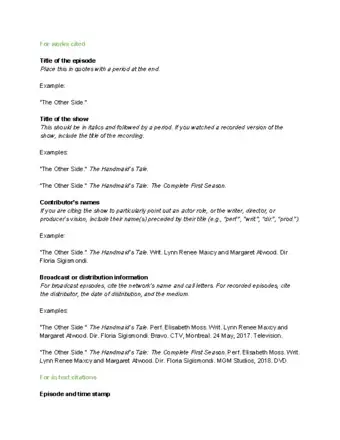

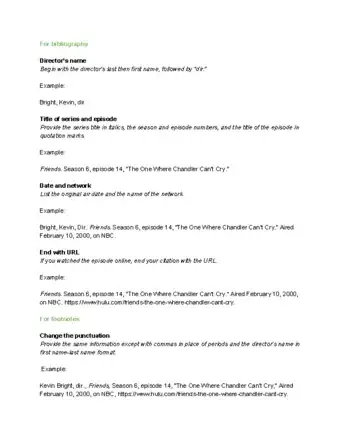



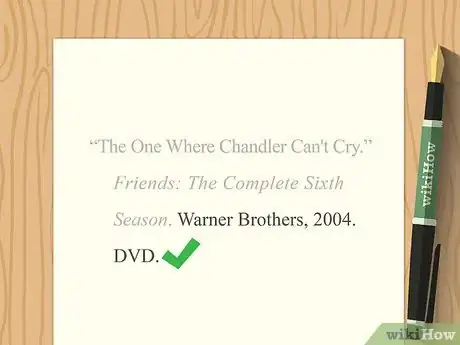
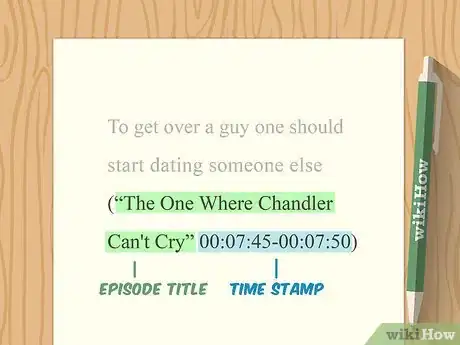
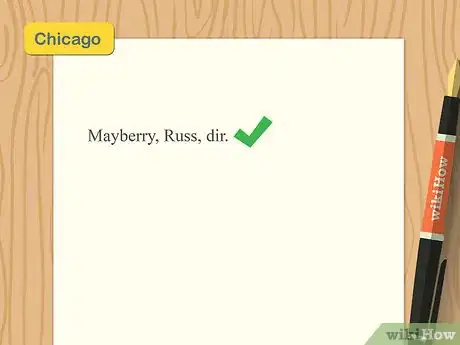
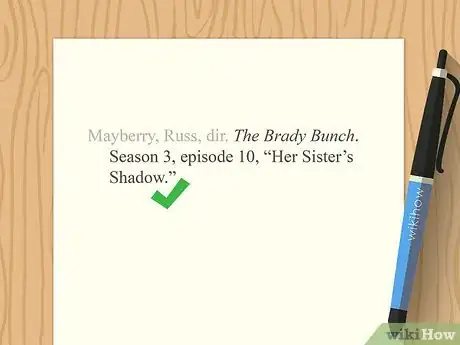
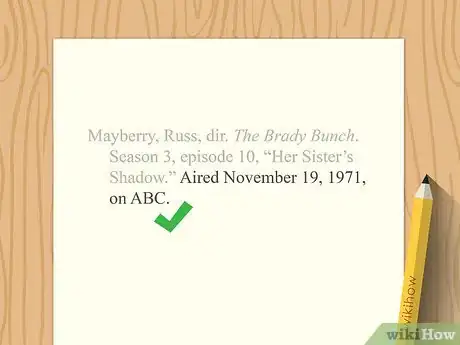
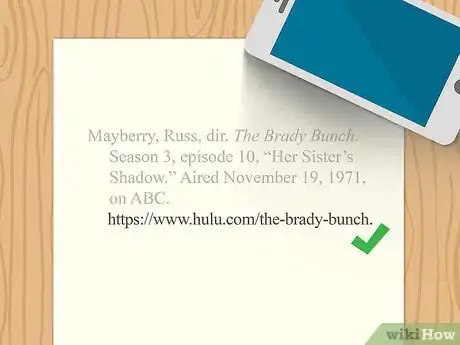
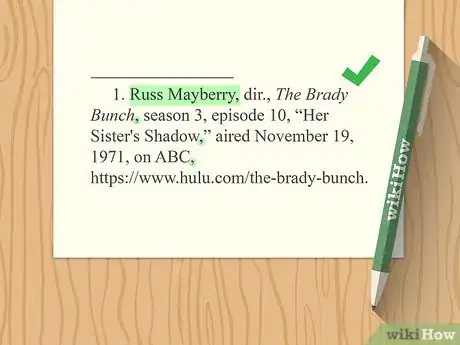
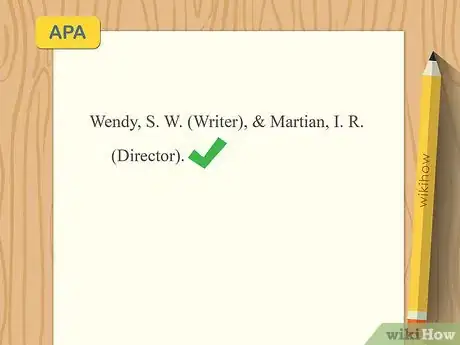
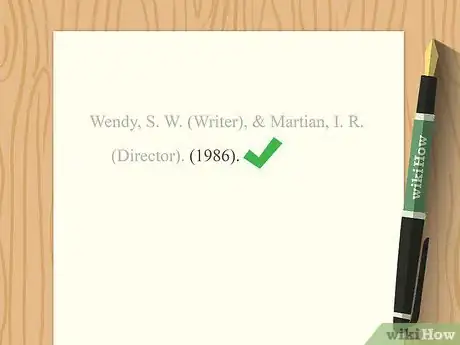
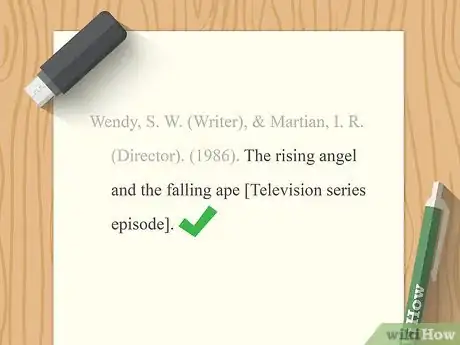
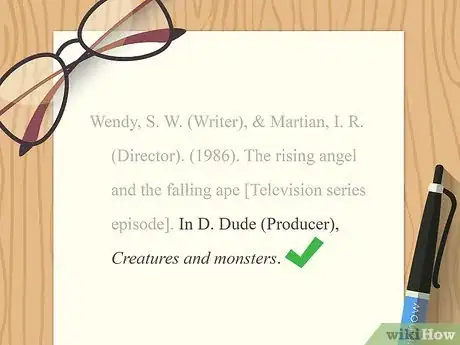
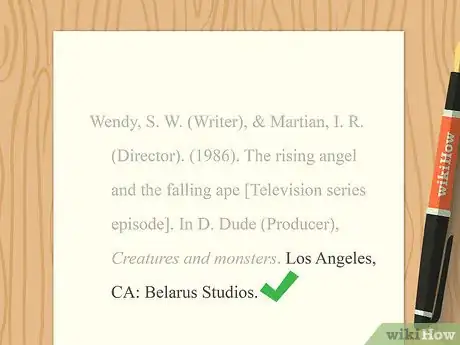
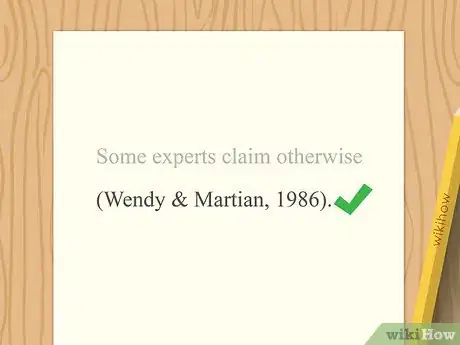







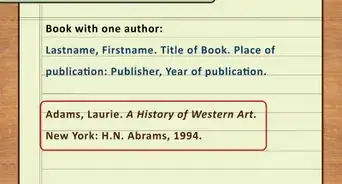


-Step-18.webp)
















































